Self Declaration Statement Samples
-
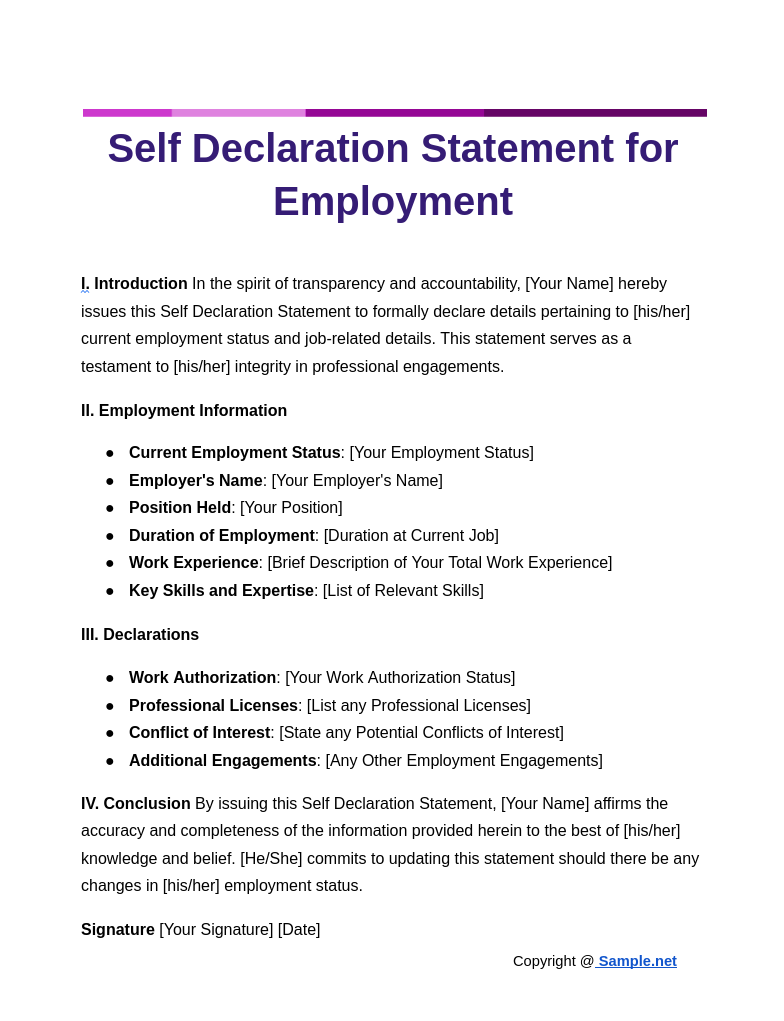
Self Declaration Statement for Employment
download now -
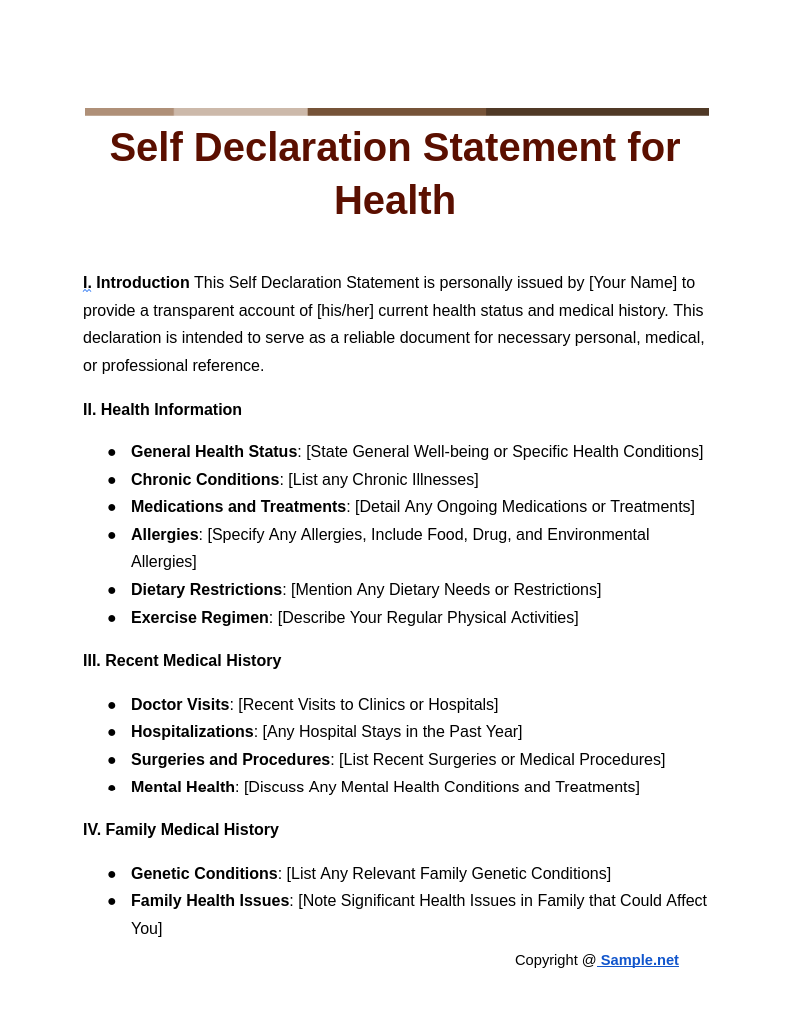
Self Declaration Statement for Health
download now -
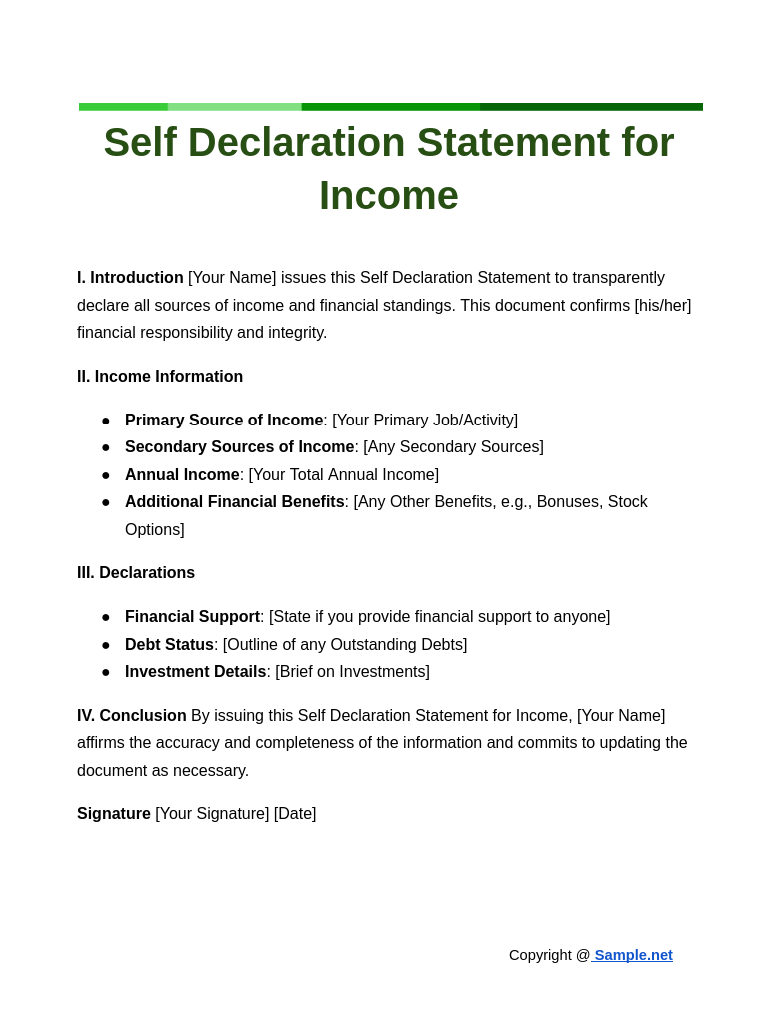
Self Declaration Statement for Income
download now -
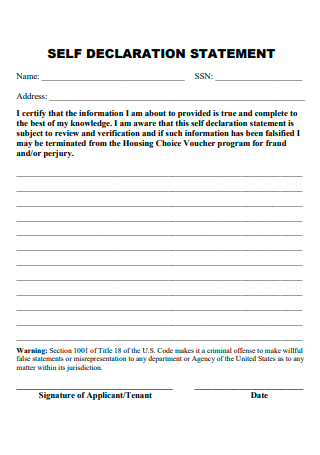
Self Declaration Statement Template
download now -

Sample Self Declaration Statement
download now -

Self Declaration Income Statement
download now -

Self Declaration Form Statement
download now
FREE Self Declaration Statement s to Download
Self Declaration Statement Format
Self Declaration Statement Samples
What Is a Self Declaration Statement?
Types of Declaration Forms
What Comprises a Self Declaration Statement?
How to Write a Self Declaration Statement?
FAQs
What are the qualities of a good self-declaration statement?
What else should be included in the self-declaration statement?
What is the difference between a declaration and an affidavit?
Where can I use a Self Declaration Statement?
How can I ensure the validity of my Self Declaration Statement?
What happens if my Self Declaration Statement is found to be false?
How long is a Self Declaration Statement valid?
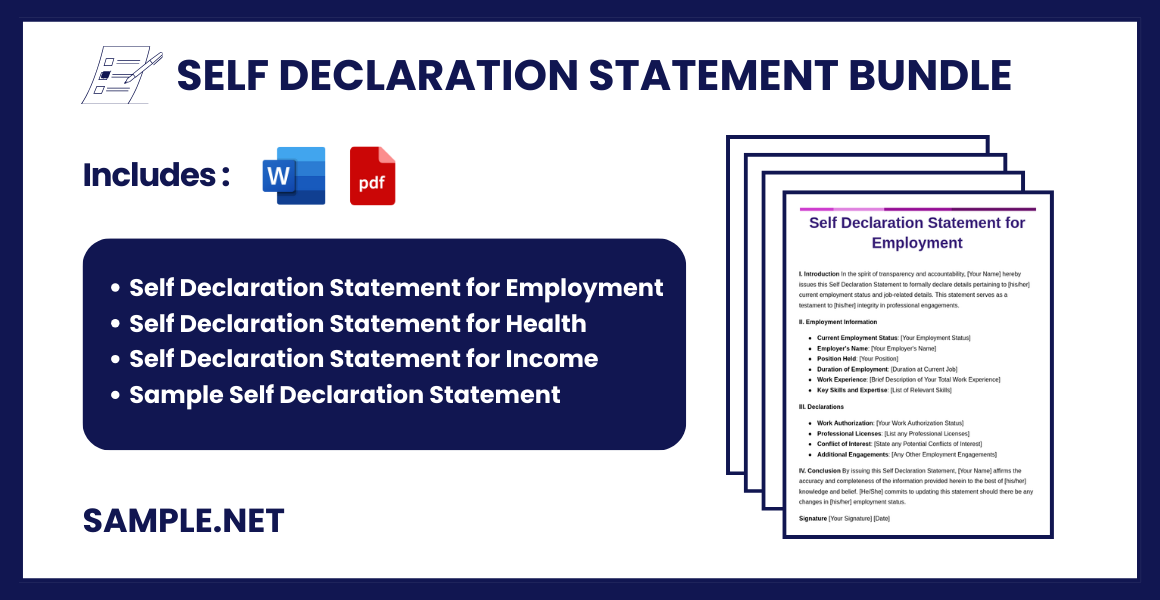
Download Community Project Proposal Bundle
Self Declaration Statement Format
I, [Your Full Name], residing at [Your Address], do hereby declare the following:
1. Identity Verification:
- Name: [Your Full Name]
- Date of Birth: [DD/MM/YYYY]
- National Identification Number: [Your ID Number]
2. Residency Information:
- Current Address: [Your Address]
- Duration of Residence: [Number of Years/Months at the Current Address]
3.Employment Status:
- Employer: [Your Employer’s Name]
- Position: [Your Job Title]
- Duration of Employment: [Number of Years/Months Employed]
4. Educational Qualifications:
- Highest Level of Education: [Your Highest Degree]
- Institution: [Name of Institution]
- Year of Graduation: [Year]
5. Financial Information (if applicable):
- Bank Name: [Your Bank’s Name]
- Account Number: [Your Account Number]
6. Health Information (if applicable):
- Known Allergies: [List of Allergies]
- Chronic Illnesses: [List of Chronic Illnesses]
I certify that the information provided above is true and accurate to the best of my knowledge and belief. I understand that any false information or omission may disqualify me from [Purpose of the Declaration, e.g., candidacy, application, etc.] and may entail further legal action.
Date: [Today’s Date]
Signature: _______________________
What Is a Self Declaration Statement?
A Self Declaration Statement is a written document in which an individual formally attests to the truth of specific information about themselves, without the need for supporting documents or third-party verification. It is often used in legal, financial, and governmental procedures to certify facts such as identity, residence, income, or other personal details. By signing the declaration, the individual takes full responsibility for the accuracy and authenticity of the provided information. Self-declaration statements are typically used in situations where immediate verification is not required, but the declaration may be subject to later scrutiny or legal consequences if found to be false. These statements are particularly useful in processes where swift processing is essential, such as applications for permits, educational admissions, or financial aid, making them a crucial part of formal documentation in various sectors. You can also see more on Authors Declaration Statement.
Types of Declaration Forms
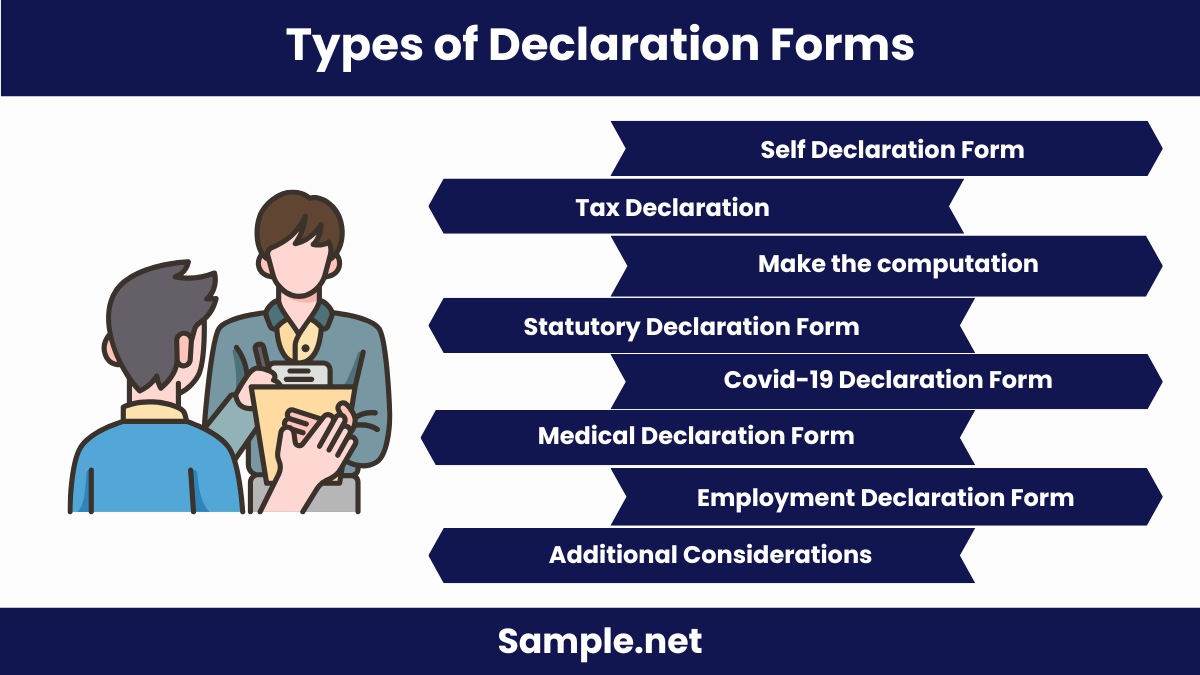
As there are multiple types of declaration forms, knowing which fits best to your situation is key in addressing the situation. Other than a self-declaration statement, there are others that can serve to be useful as well. Know more about the other types as you read through this article.
What Comprises a Self Declaration Statement?
Before we go into the steps of guiding you to write your own self-declaration statement, you would need to know what is included in the document. It is essential that you should be aware of the contents of a self-declaration statement so that you would avoid having to do changes or additions if you forget certain details. Or worse, it would not be considered legal enough because of the lack of information. You can also see more on Tenant Affidavit.
How to Write a Self Declaration Statement?
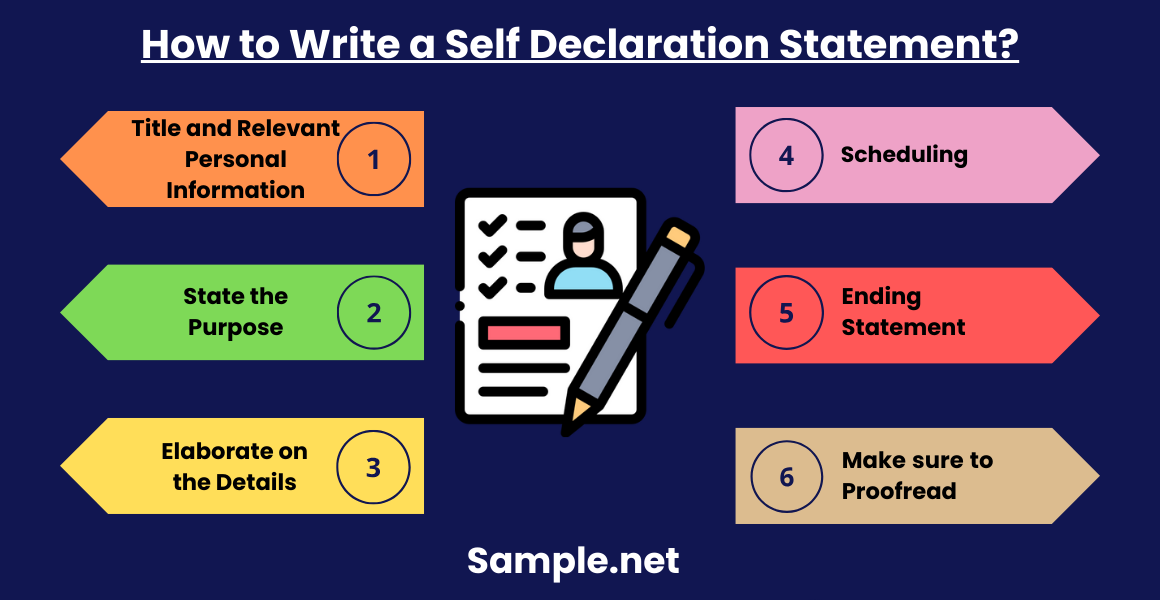
Now that a self-declaration statement and its uses have been defined, it is finally time for the steps on how to write your own document. Creating a self-declaration statement acts as an affirmation that the content you have written is factual, which is an important factor to remember. Samples of self-declaration statements are provided for you to check and use as a reference. Cutting your time in having to think over the contents since letter samples and templates make lives easier. You can also see more on Affidavit of Character.
Step 1: Title and Relevant Personal Information
Include the title of the declaration statement as well as the type so that authorities or the other party would be aware of the contents of your document. You should also mention your name, your current address, Phone and Email Contact Lists, and other necessary information that needs to be stated.
Step 2: State the Purpose
As part of your Introductory Statement, declare the purpose as to why you are writing the declaration statement. Don’t waste any time and go right to the subject.
Step 3: Elaborate on the Details
Give any additional information about the statement that you think is important. In this step, you are able to elaborate further on the necessary information that is key to your Self-declaration statement. Avoid professing any false information or exaggeration.
Step 4: Scheduling
At the end of the self-declaration statement, anticipate the requirements of your audience, in this case, the other party. They’ll want to know what impact the declaration has on them. Rather than cramming information into your letter, you might want to schedule a meeting to introduce the product and answer questions. In your letter, include the time and date of the meeting, as well as whether participation is optional or obligatory. Set up an Hourly Schedule to make sure both parties have an agreed meeting time.
Step 5: Ending Statement
Close your declaration letter on a strong note that reflects you and your present situation. You might want to make a prediction about what the statement will signify to the other party. You may issue a call to action, or the actions you anticipate others to do as a result of the statement. Alternatively, if you feel opposition coming, convey your optimism that you can gather or come together to make the declaration a success or altered. Finally, express gratitude to the other party for their time.
Step 6: Make sure to Proofread
Allow time for proofreading, editing, and revising your self-declaration statement. Since the document may serve as an assurance to the case you are addressing, make sure that the details do not have any errors in them. A professional letter sample after all does not have any mistakes present in them and it exudes professionalism if it has pristine quality.
FAQs
What are the qualities of a good self-declaration statement?
Since a self-declaration statement is a recitation of facts. Only provide material that is based on your personal experience. This refers to occurrences that you have witnessed, not those that have been reported to you by others. Firsthand observations are typically confined to talking about what you directly encountered. Admission of the truth and only the truth.
What else should be included in the self-declaration statement?
Back up your claims with evidence. If you have copies of emails, photographs, pay stubs, school records, text messages, or other documents that support the points in your declaration, include them as evidence. The attachments should be included in your declaration, make sure they are relevant to your case, and be in their original state.
What is the difference between a declaration and an affidavit?
A “declarant” is someone who makes a declaration, whereas an “affiant” is someone who submits an affidavit. Only the person who wrote the statement is allowed to sign it. They may be signed in front of a justice of the peace or legal counsel in specific instances. The author’s signature, which is attested by a commissioner of oaths or notary public, is used to authenticate self-affidavits. When a writer signs an affidavit in front of a commissioner, you recognize the risk of being charged with perjury if the statements in the signed document are untrue. See Affidavit Forms as reference.
Where can I use a Self Declaration Statement?
A Self Declaration Statement can be used in various scenarios, including applying for financial aid, verifying income or residency, or submitting applications to educational institutions or government offices.
How can I ensure the validity of my Self Declaration Statement?
To ensure the validity of your Self Declaration Statement, be truthful in all information provided, include all relevant details, and follow any required legal or procedural guidelines for the specific purpose of your statement.
What happens if my Self Declaration Statement is found to be false?
If your Self Declaration Statement is found to be false, it may result in legal penalties, including fines or prosecution. The severity of the consequences depends on the nature of the false information and the context in which the statement was used.
How long is a Self Declaration Statement valid?
The validity of a Self Declaration Statement depends on the specific use case and the requirements of the requesting authority. Some declarations may be valid indefinitely, while others may need to be updated periodically (e.g., income verification for tax purposes).
